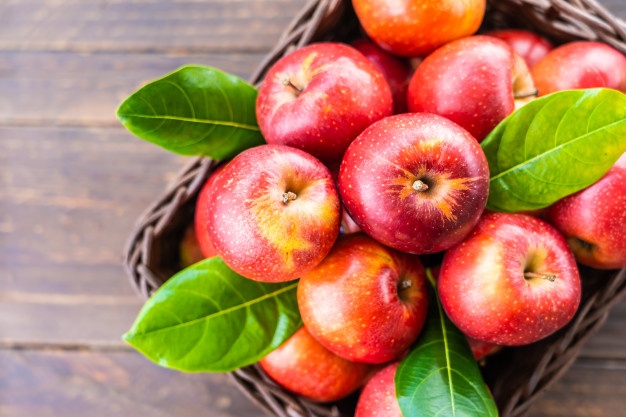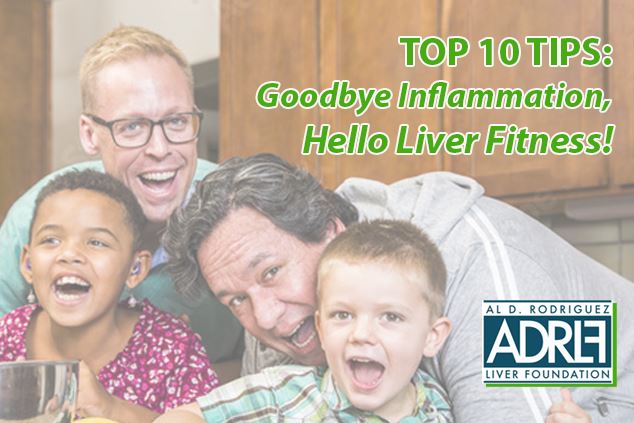While it is with great sadness that we bid summer adieu, it’s good to be reminded of the fantastic wonders that await us in the autumn season, including the distinctive and delightful colors, flavors, and scents that will be surrounding us at harvest time. Among the most beloved fall flavors is the crisp, sweet (or tart, if you prefer) apple —with its diverse range of fabulous flavors, innovative recipes, and (bonus!) health benefits.

Apples are known to lower the risk of heart disease, stroke, and, high blood pressure due to their rich soluble fiber content. Apples also contribute to good gut health and help control sugar levels, making them a healthy option for people with diabetes. And if you’ve been keeping up-to-date with ADRLF’s blog articles, you’ll remember that diabetes increases the risk of developing non-alcoholic fatty liver disease, which causes a build-up of excess fat in the liver.
So, this fall, let’s explore the liver-healthy benefits of the ever-versatile apple with these unique starters and main course recipes!
SIDE/STARTER: ROASTED APPLE BREAD (from https://thekitchenprepblog.com/)
INGREDIENTS:
2 cups chopped apple — a firm kind like Granny Smith or Cortland
1 teaspoon ground cinnamon
3 tablespoons sugar
3 ¼ cups bread flour or all-purpose flour
1 cup white whole wheat flour
1 ½ teaspoons salt
½ teaspoon instant yeast
1 ¾ cups warm water
1 teaspoon honey
1 cup coarsely chopped walnuts or pecans
INSTRUCTIONS:
- Preheat the oven to 425 degrees. Prepare a baking pan by lining with foil and spraying with non-stick spray. Place chopped apples on the pan and sprinkle with cinnamon and sugar. Bake for 10-12 minutes or until just starting to become tender. Remove from the oven, set aside (or store until later) and turn the oven off (you won’t need it again for a while).
- In a large bowl or the bowl of a stand mixer, combine the flour and salt.
- In a small bowl, stir yeast and honey into warm water, and allow to sit for 5 minutes or until it starts to foam. (You can actually toss the yeast into the flour, but I like to make sure it’s alive because I’ve used “dead” yeast too many times. The foam or “blooming” will let you know it’s alive & kicking.)
- Pour liquid into the dry mixture, and mix until the flour has all been absorbed and a sticky dough is formed. Cover the bowl with a sheet of plastic wrap and place it in a warm, dark place to rise for about 8 hours or overnight.
- When the dough has risen, turn it on onto a floured surface and work in the roasted apples and nuts, if using by folding and kneading into the dough. This part is tricky, but be patient and it will mostly work itself in.
- Grease a large stoneware baker, crock or Dutch oven (I used the ceramic insert from my slow cooker). Shape the dough into a ball and place smooth side up in the oiled dish. Cover, and let it rise for another 2 hours.
- When the bread is done rising, you may bake it directly in the vessel you’ve chosen, covered with a lid, or you can place it on a floured baking stone or pan and bake it “freeform.” If you chose the later, brush it with some water before putting it in the oven.
- Place it in a cold oven and then set the temperature to 425. Bake for 45-55 minutes or until the outside is brown and crisp and the bread sounds hollow when you tap it. If you used a lid for the baking vessel, remove it for the last 5-15 minutes of baking so the crust can brown.
- Remove from oven and allow to cool before slicing with a serrated knife.
honeycrisp apple
MAIN: SMOKY APPLE SAGE CHICKPEA VEGGIE BURGERS (from https://www.connoisseurusveg.com/ )
INGREDIENTS:
1-14 oz. can or 1 ¾ cups cooked chickpeas, drained and rinsed
1 cup panko breadcrumbs
¼ cup chickpea flour
1 small onion, quartered
2 garlic cloves, minced
3 tablespoons soy sauce
2 tablespoons apple cider vinegar
1 tablespoon smoked paprika
2 teaspoons rubbed sage
1 teaspoon dried thyme
1 teaspoon black pepper
1 medium apple, peeled and shredded (choose a sweet variety such as Gala or Cortland)
1 tablespoon olive oil
INSTRUCTIONS:
- Place chickpeas, panko, chickpea flour, onion, garlic, soy sauce, cider vinegar, smoked paprika, rubbed sage, thyme, and black pepper into food processor bowl. Pulse until ingredients are well-mixed. Add shredded apple and pulse again just until mixed.
- Transfer mixture to sealed container and chill 1 hour or overnight.
- Preheat oven to 400° and line a baking sheet with parchment. Shape the chickpea mixture into 6 patties. Brush tops and bottoms with olive oil.
- Bake 30 minutes, flipping about halfway through.
- Stuff into buns, bagels or English muffins, and top with toppings of choice. Serve.
MAIN: ONE-PAN PORK CHOPS WITH APPLES AND ONIONS (from https://www.thechunkychef.com/)
INGREDIENTS:
2 tablespoons olive oil divided
3-4 oz bone-in pork chops whatever with comfortably fit in your pan
Kosher salt and black pepper to taste
3/4 cup low sodium chicken stock
1 teaspoon Dijon mustard or whole-grain Dijon
1 tablespoon fresh sage chopped
1 1/2 tsp fresh rosemary chopped
1/2 teaspoon fresh thyme chopped
1/2 teaspoon kosher salt
1/4 teaspoon black pepper
2 medium apples thinly sliced (recommended: Gala)
1 small red onion thinly sliced
INSTRUCTIONS:
- Season both sides of pork chops with kosher salt and black pepper. Add 1 tablespoon olive oil to large heavy-bottomed pan (or skillet), and heat over medium-high heat. Add pork chops to the pan, leaving at least an inch between the chops to ensure even cooking and browning. Sear 3-5 minutes per side, or until pork chops are mostly done. Chops will continue cooking in the sauce later.
- Remove pork chops to a plate.
- In a small mixing bowl, whisk together chicken stock and mustard, set aside.
- Add remaining 1 tablespoon oil to the pan, then add apples and onions. Cook 4 minutes, stirring occasionally. Season with salt, pepper, sage, rosemary, and thyme. Stir to combine.
- Pour in the stock mixture, using a wooden spoon to gently scrape the bottom of the pan to release any brown bits (those are full of great flavor).
- Slide pork chops back into the pan, nestling them down in between the apples.
- Cook 2-3 minutes until pork chops are finished cooking and liquid has been reduced by half.







































